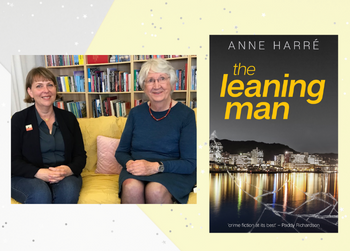For your delight, edification, and enjoyment our very special interview with debut crime novelist and author of The Leaning Man Anne Harré in conversation with Dame Fiona Kidman.
Filmed at her publisher’s office by Wellington City Library staff. This wide-ranging interview with Anne covers The Leaning Man’s origins and creation, her love of Wellington and how Anne approaches her writing, not to mention how it feels to release your first novel.
 Anne Harré’s debut novel The Leaning Man is a newly-released, gripping, suspenseful page-turning thrill ride of a book (you are very likely to stay up very late to see what happens next). It is set in our very own windy Wellington and in some respects is a love letter to the city with its perfectly visualised, vivid, and evocative descriptions of the capital. And to top it all one of the locations in the book is our very own Te Awe Library, with accompanying fictional librarian.
Anne Harré’s debut novel The Leaning Man is a newly-released, gripping, suspenseful page-turning thrill ride of a book (you are very likely to stay up very late to see what happens next). It is set in our very own windy Wellington and in some respects is a love letter to the city with its perfectly visualised, vivid, and evocative descriptions of the capital. And to top it all one of the locations in the book is our very own Te Awe Library, with accompanying fictional librarian.
The book has already gained glowing reviews in The Listener, The Dominion Post as well as RNZ.
We wish to extend our heartfelt thanks to Anne Harré, Dame Fiona Kidman and Mary McCallum for making this interview happen. This interview was done in conjunction with The Cuba Press and Creative New Zealand.
 The leaning man / Harré, Anne
The leaning man / Harré, Anne
“It’s Saturday night down on the wharf. Celebrations are in full swing for the Westons’ fortieth wedding anniversary. Their daughter Stella has returned from London to attend. Once shoulder-tapped as detective material, a few bad decisions and a questionable ethical dilemma saw her leave the force under a cloud. She’s now a private investigator in London, reduced to filming errant husbands for court cases. She doesn’t want to be home. Later that night her best friend Teri is found dead in a lane in the central city. Her phone is missing. It looks like suicide, but Stella won’t believe it.” (Catalogue)
This mortal boy / Kidman, Fiona
“Albert Black, known as the ‘jukebox killer’, was only twenty when he was convicted of murdering another young man in a fight at a milk bar in Auckland on 26 July 1955. His crime fuelled growing moral panic about teenagers, and he was to hang less than five months later, the second-to-last person to be executed in New Zealand. But what really happened? Was this a love crime, was it a sign of juvenile delinquency? Or was this dark episode in our recent history more about our society’s reaction to outsiders.” (Catalogue)



